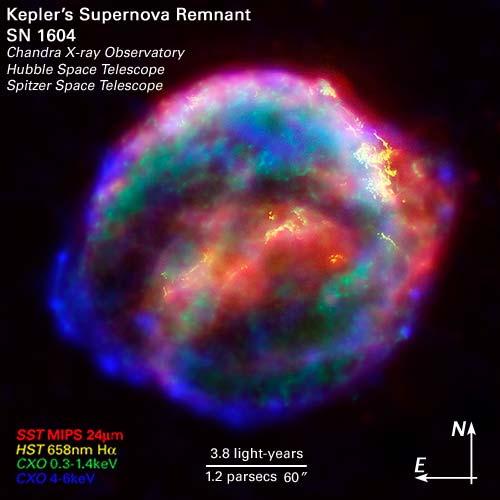Credit & Copyright: courtesy STScI
Explanation:
Light from the stellar explosion that
created this energized cosmic cloud was first seen on planet
Earth in October 1604, a mere
four hundred years
ago.
The supernova produced a bright
new star
in early 17th century skies within the constellation
Ophiucus.
It was studied by astronomer
Johannes Kepler
and his contemporaries, with out the benefit of a telescope, as they
searched for an explanation of the heavenly apparition.
Armed with a
modern
understanding of stellar evolution,
early 21st century
astronomers continue to explore the
expanding debris cloud, but can now use
orbiting space telescopes to
survey Kepler's supernova remnant (SNR)
across the spectrum.
In this tantalizing composite image,
x-rays,
visible light, and
infrared
radiation recorded by NASA's astrophysical
observatories - the
Chandra X-Ray Observatory,
Hubble and
Spitzer
space telescopes - are combined to give a more comprehensive
view of the still enigmatic supernova remnant.
About 13,000 light years away,
Kepler's supernova
represents the most recent stellar explosion seen to
occur within
our Milky Way galaxy.
1999 2000 2001 2002 2003 2004 2005 2006 2007 2008 2009 2010 2011 2012 2013 2014 2015 2016 2017 2018 2019 2020 2021 2022 2023 2024 2025 |
Январь Февраль Март Апрель Май Июнь Июль Август Сентябрь Октябрь Ноябрь Декабрь |
NASA Web Site Statements, Warnings, and Disclaimers
NASA Official: Jay Norris. Specific rights apply.
A service of: LHEA at NASA / GSFC
& Michigan Tech. U.
|
Публикации с ключевыми словами:
supernova - supernova remnant - kepler - optical - infrared - остаток Сверхновой - Кеплер - рентгеновское излучение - оптическое излучение - инфракрасное излучение
Публикации со словами: supernova - supernova remnant - kepler - optical - infrared - остаток Сверхновой - Кеплер - рентгеновское излучение - оптическое излучение - инфракрасное излучение | |
См. также:
Все публикации на ту же тему >> | |
